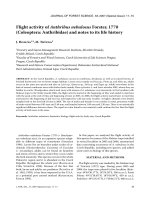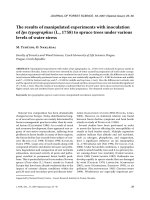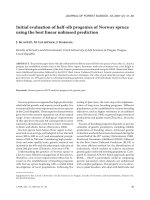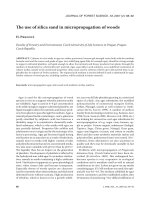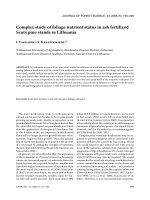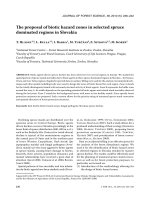Báo cáo lâm nghiệp: "Natural regeneration of sessile oak under different light conditions" pptx
Bạn đang xem bản rút gọn của tài liệu. Xem và tải ngay bản đầy đủ của tài liệu tại đây (596.96 KB, 10 trang )
J. FOR. SCI., 57, 2011 (8): 359–368 359
JOURNAL OF FOREST SCIENCE, 57, 2011 (8): 359–368
Supported by the Ministry of Education, Youth and Sports of the Czech Republic, Project No. 6215648902, and by the
Ministry of Agriculture of the Czech Republic, Project No. QI102A085.
Natural regeneration of sessile oak under different light
conditions
I. Březina
1
, L. D
2
1
Training Forest Enterprise of Masaryk Forest in Křtiny (special-purpose facility of Mendel
University in Brno), Brno, Czech Republic
2
Department of Silviculture, Faculty of Forestry and Wood Technology, Mendel University
inBrno, Brno, Czech Republic
Abstract: Different variants of regeneration felling or different light conditions (total site factor 15–95%) and weed
control were evaluated in relation to the 4-year development of individuals of regenerated sessile oak. The regenera-
tion density is not dependent on light conditions. The highest mortality occurs on the open area of clear felling. For
a certain time in youth, it is possible to consider oak as a shade-tolerating species. With the increasing light intensity
the diameter and height growth of oak seedlings increases proportionally, being the highest at 100% light intensity.
However, to support at least medium-fast growth, the species requires minimally 50% light intensity (smaller closed
clear-felled areas). On the other hand, more extensive unprotected cleared areas appear to be quite unsuitable at the
initial stages of regeneration. The positive effect of weed control on the success and growth of natural regeneration
is questionable. We recommend developing the regenerated stand by means of a series of small-area (about ≤ 0.3 ha)
two-stage felling with a medium-long regeneration period (15–20 years).
Keywords: sessile oak; natural regeneration; light conditions; close-to-nature forest management
At lower locations of the Czech Republic, oak is
one of the most important commercial species. e
natural proportion of oak within the CR is estimat-
ed to be about 19%, the present proportion rang-
es about 7%. A long-term silvicultural target is to
maintain this proportion or to increase it slightly.
In the CR, methods of artificial regeneration have
been well managed from the aspect of both re-
search and practice. However, principles of close-
to-nature forestry force foresters more and more
to change thinking and standard stereotypes. e
basic building element of this conception and fre-
quently also its pitfall is natural regeneration or the
shelterwood system of management. It is interest-
ing for forest practice if and under what conditions
it is possible to take into account natural regenera-
tion of oak.
Natural regeneration of oak is of considerable
importance. At proper regulation, it provides the
best biological results not requiring high costs
(V 1958). Compared with pedunculate oak
preferring higher locations and drier soils ses-
sile oak is considered to be a semi-sciophyte in
youth, at higher age a heliophilous species (e.g. R-
2001; R, B 2006 etc.). Accord-
ing to P et al. (1964), oak advance growth
is very sensitive to late frosts. If it is suddenly re-
leased, it suffers from sunstroke. In youth, it toler-
ates shading by a parent stand, which is very impor-
tant from the aspect of its protection. According to
R, B (2006), oak is able to survive at
15% relative radiation of an open area for several
years. For sustainable growth, it needs at least 20%.
Under these conditions, however, height increment
360 J. FOR. SCI., 57, 2011 (8): 359–368
and particularly diameter increment are reduced to
a half as well as metabolism and the development
of roots. L (1998) found natural regeneration
already at values of relative radiation exceeding
10% (broken canopy), but certainly at values over
15–20% (gaps in canopy of a diameter of 17–25 m,
about 0.05 ha). Height increment increased rough-
ly up to 40% relative radiation being then constant.
For the successful growth of oak, 30–60% relative
radiation is necessary (open canopy, gaps up to
0.2ha). D et al. (2008) recommended the size of
gaps to be 0.03–0.05 ha (diffusion radiation 8–18%)
for the successful regeneration of pedunculate oak.
Within particular gaps, they found the most suit-
able conditions for the oak advance growth to be in
their centre and northern part. ey recommended
the creation of elliptic gaps with a longer northern
part. After the first 4 years of the life of oak seed-
lings, the authors recommended to extend gaps to
about 0.1 ha because of the quality development of
regenerated individuals.
According to K (2010), shaded oak trees
show very good shape and fine branching. W-
(2000) found out that gaps with relative ra-
diation exceeding 32% did not have any negative
effects on the quality development of seedlings.
D et al. (2008) did not find any relationships
between the quality of seedlings and light inten-
sity. However, particular older oak trees growing in
small gaps showed unfavourable slenderness ratio
(h/d ratio) and grew outside the stem vertical axis.
Relationships between the growth of oak and light
intensity were summarized by R and G
(2007) as follows: the height growth of oak is higher
under conditions of stand shade than on the open
area; in the first years, maximum height growth of
the seedlings is achieved at the relative light inten-
sity 20–40% or 25–50% in the second year of life.
Light reduction results in higher height increment,
larger leaf area and the higher content of chloro-
phyll, however, it also results in the insufficient
development of a root system, lower metabolism,
lower assimilatory capacity and generally lower
growth performance.
However, the majority of the authors do not con-
sider light to be a primary factor limiting the vitality
of oak regeneration. S (1991) (in W
2000) recommended the minimum area for oak
regeneration from 0.25 to 0.3 ha because of snow
damage and distortion. Similarly, R and
B (2006) recommended rich light intensity
to prevent stem distortion and forking the leading
shoot. e appearance of forest weed, unlike other
species, does not threaten young oaks. All authors
consider competition with other species, e.g. shade
trees (hornbeam, beech, lime), to be one of the
main limiting factors of the natural regeneration
of oak. erefore, R and B (2006)
recommended increasing particularly light inten-
sity. us, oak can take growth advantages before
these species. e failure of natural regeneration of
oak can be then attributed particularly to brows-
ing damage, insect (Tortrix viridana) damage, pre-
dation (birds, rodents), fungal attack and diseases
(Microsphaera alphitoides), massive occurrence of
forest weeds, late frosts (R, G 2007).
In silvicultural considerations, it is necessary to
start from a fact that sessile oak as a semi-sciophi-
lous species is able to grow under various ecological
conditions. In initial stages of natural regeneration,
the oak regeneration requires protection provided
through its parent stand, in next stages its demand
on light increases. On the basis of these findings, it
is possible to recommend using shelterwood felling.
us, the area and time intensity of accretion cut-
ting will be a controversial issue. B (2001)
recommended both large-area and small-area
(suitable particularly in larger tracts of oak stand
where there is an interest in achieving various age
structures) shelterwood felling. R et al. (2006)
and similarly also M et al. (1999) (pedunculate
oak) recommended to use rather large-area shelter-
wood felling with a short regeneration period. L
(2008) also came to similar conclusions when he rec-
ommended clear felling with the use of seed trees
based on the comparison of three variants of the re-
generation of a mixed oak-beech stand (1
st
irregular
shelterwood – 3 gaps of a diameter of 23m, mean
value of relative radiation 26%; 2
nd
group shelter-
wood – 2 gaps of a diameter of 30m, relative radia-
tion 35%; 3
rd
clear felling with reserved trees – clear-
cut with few remnants, relative radiation 70%), to
carry out quickly clear felling leaving reserved trees.
On the other hand, D et al. (2008) emphasized
ecological disadvantages of large-area shelterwood
felling recommending rather small-area procedures.
Z (1969) (in K 2010) reported the
failure of natural regeneration at large-area shelter-
wood felling when weed infestation occurred due
to ash. Even clearcut gaps were not suitable. Shel-
terwood gaps of an area of 0.015 ha appeared to be
successful. K (2010) regarded 0.01 ha shelter-
wood gaps as optimal for the regeneration of oak.
According to L (2008), small-area close-to-na-
ture management weakens competitive advantages
of oak as against other tree species.
However, it is not quite proved by supporters
of the often discussed conception of “natural oak
J. FOR. SCI., 57, 2011 (8): 359–368 361
regeneration with permanent canopy cover” (e.g.
L 1998; W 2000; D et al. 2008).
e aim of our paper is to compare the effects
of different variants of regeneration felling on the
successfulness and growth response of sessile oak
regeneration at nutrient-rich sites of medium-alti-
tude locations.
MATERIAL AND METHODS
In the area of the Training Forest Enterprise in
Křtiny, Masaryk Forest, Mendel University in Brno
(Vranov Forest District), three stands were selected
(Table 1) in a regeneration stage with dominant ses-
sile oak. e stands are situated at medium-altitude
locations (altitude about 440 m a.s.l.) on slightly
steep land at nutrient-rich sites – 2H, 3B (site type
units of the Czech typological system).
In all cases, the parent rock consists of granodio-
rite to granite, the soil type is Luvic Cambisol. Fagi-
Querceta typica are potential vegetation (maps of
the Czech typological system). Galium odoratum,
Poa nemoralis, Melica nutans, Luzula luzuloides
and Festuca altissima dominate in the herb layer in
the actual stand type.
In each of the stands, 1 research polygon (RP)
was established in such a way that it would repre-
sent the variability of stand conditions. e actual
natural regeneration of oak comes from the 2002
seed year. In 2003, 5 variants of regeneration were
carried out within RP I, II (about 1.5 ha) – (a) no
felling, (b) small-area shelterwood felling of vari-
ous intensity (initial and seed stage), (c) cutting
face (about 0.2–0.3 ha) – at one stand height with
the lateral shading of a parent stand from two sides
at least, (d) cutting face (about 0.5 ha) as the outer
edge of border cutting (shading of a parent stand
from one side) at 1.5 stand height, RP III (0.8 ha),
(e) clear felling (0.8 ha). To evaluate light condi-
tions, hemispherical photos were taken within RP
I, II in a 10 × 10 m grid (Nikon Coolpix 4500 + Fish-
Eye FC-E8). For the purpose of comparison (RP I vs
RP II), weed control was carried out at RP I each
year. e 3% concentration of Roundup Classic was
applied with a knapsack sprayer onto the whole
surface before budding once ayear.
Monitoring of the natural regeneration of sessile
oak was carried out from 2007 to 2010. Across RP,
five transects were laid out to characterize various
degrees of shading. Transects consisted of the series
of plots 2 × 2 m in size (in total 476 plots). On each
plot, the following parameters of oak regeneration
were determined each year: density – N or mortal-
ity – M (as of 2010 compared to 2007), height – h
in 2007, height increment – h
i
(separately Lammas
shoot and spring increment) and diameter at the
root collar – d.r.c. in 3 successive years.
To evaluate relationships between variants of re-
generation or light conditions and parameters of
oak natural regeneration it was necessary to derive
degrees of light intensity. Hemispherical photos
were analysed using the WinsCanopy programme.
For the purpose of this paper parameters of rela-
tive total radiation were used, namely total site
factor – TSF and canopy openness. Based on the
relationship of both variables (Fig. 1), 4 degrees of
significantly different light intensity (Table 2) were
Table 1. Forest inventory (2003–2012) of examined stands
Stand Area (ha) Age (year) Density (%) Stock (m
3
·ha
–1
) Composition (%) RP
55B13b 4.1 126 90 312 oak 87, Douglas fir 5, pine 3, beech 3, larch 2 I
56B12a 15.5 119 90 368 oak 70, larch 18, spruce 4, pine 3, beech 3, Silver fir 2 II
21C13 0.8 130 50 179 oak 58, pine 33, larch 5, spruce 2, beech 2 III
Fig. 2. A map of degrees of light intensity (RP I, II) and
canopy openness
degree of light intensity
transect
362 J. FOR. SCI., 57, 2011 (8): 359–368
derived for RP I and II when about a 20% increase
in TSF meant a 10% increase of canopy openness.
In the open area (RP III), the TSF value of 100% was
supposed (degree 5).
In the ArcMap 10 application, a virtual light map
has been created where degrees of light intensity for
RP I, II and the position of transects are displayed
(Fig. 2). e spatial division of degrees of light in-
tensity corresponds to the distribution of regenera-
tion variants: (1) = full or slightly broken canopy,
(2) = broken canopy (with small gaps), (3)and (4) =
clear-felling element with various light conditions.
Effects of factors – light intensity (at all RP) and
chemical control (only at RP I, II) were tested using
non-parametric ANOVA.
RESULTS
Development of oak regeneration density
(mortality)
e total mean density of oak seedlings, which
was about 80 thousand/ha (min 5–max 682.5thou-
sand), decreased in the course of the 4-year devel-
opment to a half, i.e. 40 thousand individuals per ha
(min 0–max 275 thousand) as follows: in 2008 the
decline was by 20 thousand and every other year by
10 thousand. Effects of the degree of light intensity
are not quite significant in that case. e signifi-
cantly lowest number of seedlings at the beginning
and at the end of the monitored period was found
Fig. 3. e development of
regeneration density (N) at
particular degrees of light
intensity
N_2007
N_2008
N_2009
N_2010
200
180
160
140
120
100
80
60
40
20
0
N (tsd. ha
–1
)
N_2007
N_2008
N_2009
N_2010
1 2 3 4 5
Degree of light intensity
y
= 16.472e
0.014x
R
2
= 0.756
10
20
30
40
50
60
70
10 20 30 40 50 60 70 80 90 100
TSF (%)
Canopy openness (%)
Fig. 1. Degrees of light intensity ac-
cording to TSF
J. FOR. SCI., 57, 2011 (8): 359–368 363
Table 2. Characteristics of particular degrees of light intensity
Degree of light intensity (TSF %)
1
(15–30)
2
(30–50)
3
(50–70)
4
(70–95)
5
(100)
Area (%) 22 42 19 17
TSF (%)
(Median, min–max)
25.3
14.4–31.7
41.6
28.8–55.9
62.2
49.4–75.9
88.1
69.8–94.9
100
Canopy openness (%)
(Median, min–max)
23.2
16.3–32.5
28.9
17.6–38.6
39.6
29.4–50.9
61.2
36.4–64.0
Significance *** *** *** ***
TSF – total site factor
Table 3. e development of regeneration density and mortality according to degrees of light intensity and chemical
control (grey colour = significant, P < 0.05)
Degree
1 2 3 4
5
no
1-4
Weed control
yes no yes no yes no yes no yes no
Year
2007 87.50 65.00 87.50 90.00 70.00 57.50 137.50 97.50 47.50 95.00 80.00
2008 65.00 62.50 57.50 85.00 60.00 50.00 100.00 85.00 30.00 63.75 67.50
2009 42.50 57.50 45.00 67.50 45.00 40.00 75.00 70.00 12.50 50.00 60.00
2010 27.50 48.75 32.50 55.00 35.00 37.50 55.00 57.50 12.50 38.75 50.00
Mortality (%) 58 27 59 30 60 45 57 40 74 59 31
1 2 3 4 5
Degree of light intensity
Mortality (%)
90
80
70
60
50
40
30
20
10
at degree 5. e highest number of seedlings was
determined at degree 4 as compared to degrees 1,
3 and 5 (Fig. 3). e absolute values of regenera-
tion density could be affected at degree 5 (RP III)
by low stocking of the original stand (Table 1), i.e.
by the lower number of parent trees; assessing the
relative mortality was exact. e total mortality of
seedlings (as of 2010) was significantly highest at
degree 5. Otherwise, it did not differ within par-
ticular degrees (the mean value was lowest at de-
gree1) (Fig. 4).
e factor of weed control is statistically significant,
however, the positive effects have not been proved
(Table 3). While at the beginning of the monitored pe-
riod there was a significantly higher number of seed-
lings on the plot with protection, in the next year the
number of seedlings did not differ. Surprisingly, in the
other years the density of seedlings was significantly
higher on the plot without protection. e total mor-
tality of seedlings was also significantly lower on the
plot free of protection (by a half). It was evident par-
ticularly with the decreasing degree of light intensity.
Fig. 4. e development of regeneration mortality at
particular degrees of light intensity
364 J. FOR. SCI., 57, 2011 (8): 359–368
e development of diameter and height
growth of oak regeneration
e mean diameter of the root collar of oak seed-
lings, which was about 2.8 mm (min 1.2–max 9.0mm)
in 2008, increased to 6.1 mm during two years (min
2.5–max 23 mm). e mean height increment of
oak seedlings, which started from the mean height
of 16.7 cm (min 5–max 59.6cm) in 2007, amounted
to9.1 cm (min 1.8–max 33.1cm.) in 2008, increas-
ing in the next years: 2009 ‒ 15.2cm (min 1.8–max
44.3 cm), 2010 ‒ 16.5 cm (min 2–max 65.3 cm).
In both parameters, the degree of light intensity
is an important factor when the mean values of di-
1 2 3 4 5
Degree of light intensity
20
18
16
14
12
10
8
6
4
2
0
d.r.c. (mm)
d.r.c._2008
d.r.c._2009
d.r.c._2010
Fig. 5. The development of
regeneration diameter incre-
ment at particular degrees of
light intensity
d.r.c. – diameter at the root collar
Table 4. e development of diameter growth and the total diameter increment according to degrees of light intensity
and chemical control (grey colour = significant, P < 0.05)
Degree
1 2 3 4
5
no
1–4
Weed control
yes no yes no yes no yes no yes no
Year
2008 2.5 2.1 3.0 2.2 3.2 2.7 3.8 4.3 4.3 3.1 2.4
2009 3.7 2.9 4.7 2.9 5.6 4.2 6.8 6.5 7.0 5.0 3.2
2010 4.9 3.9 6.4 3.8 7.0 5.9 9.1 9.9 15.6 6.5 4.2
d.r.c. increment (mm) 2.4 1.7 3.1 1.7 3.8 3.3 4.7 5.6 11.1 3.2 1.9
d.r.c. – diameter at the root collar
Fig. 6. e total increase in regeneration diameter incre-
ment at particular degrees of light intensity
1 2 3 4 5
Degree of light intensity
16
14
12
10
8
6
4
2
0
d.r.c. (mm)
J. FOR. SCI., 57, 2011 (8): 359–368 365
ameter and height increment increase with the in-
creasing degree of light intensity (Fig. 5).
At the beginning of the monitored period (2008 to
2010), the diameter of root collar was also quite bal-
anced being significantly lower at degrees 1, 2 and 3
as compared to degrees 4 and 5. ese differences
steadily increased and so, in 2009, the diameter was
smaller at degrees 1 and 2 as compared to degrees 3,
4 and 5 and in 2010, the values of diameters differed
at all degrees. e total increase in the root collar
diameter in the monitored period was different at all
degrees except degrees 1 and 2 (Fig. 6).
1 2 3 4 5
Degree of light intensity
160
140
120
100
80
60
40
20
0
h+h
i
(cm)
h_2007
h
i
_2008
h
i
_2009
h
i
_2010
Fig. 7. e development of
regeneration height incre-
ment at particular degrees
of light intensity
h – height
h
i
– height increment
Table 5. e development of height growth and the total height increment according to degrees of light intensity and
chemical control (grey colour = significant, P < 0.05)
Degree
1 2 3 4
5
no
1–4
Weed control
yes no yes no yes no yes no yes no
Year
h_2007 15.0 11.0 17.0 11.2 18.6 13.2 19.4 19.4
41.9
17.5 12.2
h
i
_2008 10.5 5.7 8.4 5.9 9.9 13.4 14.1 13.7 22.4 9.9 6.7
h
i
_2009 15.3 7.2 15.8 6.8 18.1 20.2 21.4 23.8 26.8 16.4 8.5
h
i
_2010 14.8 8.5 17.4 7.9 18.2 20.7 19.8 33.4 36.0 17.9 9.6
h
i
sum (cm) 39.0 20.1 43.0 19.4 48.9 58.0 55.5 67.3 84.5 45.6 22.9
h – height; h
i
– height increment
Fig. 8. e total increase in regeneration height increment
(h
i
) at particular degrees of light intensity
1 2 3 4 5
Degree of light intensity
h
i
(cm)
110
100
90
80
70
60
50
40
30
20
10
366 J. FOR. SCI., 57, 2011 (8): 359–368
In 2007, the height of seedlings was quite bal-
anced being significantly the highest at degrees 4
and 5. In 2008, the height increment could be di-
vided into 3 groups (Fig. 7): significantly lowest at
degrees 1 and 2, followed by degrees 3 and 4 and
the highest increment was at degree 5. is trend
continued until the end of the period of monitor-
ing; it was also evident at the evaluation of devel-
opment of the total height increment of seedlings
(Fig. 8). e Lammas shoot increment was signifi-
cantly higher compared to the spring increment at
all degrees of light intensity (Fig.9). e factor of
weed control was statistically significant; however,
it was not possible to unambiguously demonstrate
any positive effects even there (Tables 4 and 5). e
mean root collar diameter and height increment
were significantly higher on the plot with chemical
control than on the plot without protection in all
years (degrees 1–4). However, it applied particu-
larly to the degrees of low light intensities, namely
1 and 2. At degrees 3 and 4, the root collar diam-
eter was equal (insignificant) for both variants in
the particular years (except at degree 3 in 2009).
e height growth was balanced at degrees 3 and 4,
or in some cases, the height growth was higher on
plots without chemical control.
DISCUSSION
Our research has proved general findings of many
authors, namely that oak behaves as a shade-toler-
ating species in youth being able to survive under
less favourable light conditions for a certain time.
In our case, 8-year seedlings occurred in quite an
abundant number (about 40 thousand individuals
per ha) independently of the degree of light inten-
sity (Table 6), namely even at minimum values of
total radiation circa 15%, i.e. in a fully-closed stand.
us, we cannot confirm the conclusions of R-
(1948) (in V 1958) that self-seeding dies
at stocking 0.8–0.9 after 6–7 years. e period of
survival was longer. e mortality of individuals of
regeneration did not decrease with increasing light
intensity but rather on the contrary, it increased
and the fast release on a larger clear-felled area
(see degree 5) caused the absence of regeneration
individuals (12.5 thousand seedlings per ha) and ir-
regular coverage of the area.
After the application of large-area two- to three-
stage shelterwood felling, M et al. (1999) con-
sidered natural regeneration of pedunculate oak
to be successful if it reached the density of about
40thousand seedlings per ha. According to V-
Table 6. Spearman correlation of the regeneration growth parameters with light conditions
N_2007 N_2008 N_2009 N_2010 Mortality d.r.c. increment h
i
sum
Canopy openness (%) 0.19 0.02 -0.02 -0.08 0.36 0.55 0.60
TSF (%) 0.18 0.09 0.10 0.07 0.13 0.57 0.53
TSF – total site factor; d.c.r. – diameter at the root collar; h
i
– height increment
1 2 3 4 5
Degree of light intensity
h
i
(cm)
60
50
40
30
20
10
0
h
i
_spring
h
i
_Lammas shoot
Fig. 9. Comparison of total
height increments (h
i
) of spring
and Lammas shoots
J. FOR. SCI., 57, 2011 (8): 359–368 367
(1958), numerous studies proved that the
number of oak seedlings which originated under
the old stand decreased on older clear-felled areas.
Some older papers (e.g. V 1958; P et
al. 1964) reported the danger of late frosts and sun
scorch in suddenly released seedlings as the most
frequent cause of this event. May late frosts, which
occur particularly at locations with the limited out-
flow of cold air mainly at the high density of grass
vegetation (heat removal), are especially dangerous
(R, G, 2007).
Another situation occurs when taking into ac-
count the actual growth of seedlings. We confirm
here a generally known finding that the growth per-
formance of oak seedlings increases with increas-
ing light intensity (Table 6). It was of interest that
even at the lowest degree of light intensity, i.e. in a
fully closed stand, height and diameter increments
of oak seedlings increased. In detail it is possible to
differentiate 4 types of growth in this trend: (1) slow
(light intensity below 50%), (2) medium fast (light
intensity 50–70%), (3) fast (light intensity 70–95%),
(4) very fast (light intensity 100%). ereat Lammas
shoot increment is higher than spring increment,
which was acknowledged e.g. by R (2001).
We cannot confirm the statement of some authors
(e.g. R, G 2007; L 1998 etc.) that the
maximum height increment culminates at values of
relative light intensity 30–50%, i.e. under the canopy
of a parent stand. In our case, the values of diameter
and height increments increased proportionally to
light intensity, the highest values being on the open
area with relative light intensity 100%. is fact was
partly confirmed also by L (2008). By the com-
parison of 3 types of regeneration felling (mixed
beech-oak stands), the author found the highest val-
ues of height on the open area with left reserved trees
as compared with the other variants (group shelter-
wood felling). According to the author, the cause con-
sists in the uneven age of seedlings, different degree
of light intensity and competition with beech.
e expected effect of weed control on the suc-
cess and growth of natural regeneration has not
been proved, being rather questionable. Neverthe-
less, many authors (e.g. R, B 2006;
R, G 2007) did not see a fundamental
problem in weed competition in oak (unlike other
tree species). According to findings of forest prac-
tice, however, chemical protection can be impor-
tant for the creation of mixed stands, particularly
for the natural regeneration of larch, pine, cherry
and other tree species in mixtures with oak. Un-
der given conditions, the mechanical preparation
of soil was not necessary.
e parameters of natural regeneration analysed
here do not show evidence of the quality of indi-
viduals of regeneration, which cannot be ignored in
silvicultural considerations and decision-making.
In our research, we would like to verify the findings
of W (2000) that gaps with relative light
intensity exceeding 32% do not affect fundamen-
tally the quality of oak. It would also be of interest
to assess the ratio of the sizes of the root system of
seedlings and their aboveground parts, which will
undoubtedly show a substantial effect on the stabil-
ity and quality of a subsequent stand.
CONCLUSIONS AND RECOMMENDATIONS
FOR FOREST PRACTICE
Research initiated by forest practice of the Křtiny
Training Forest Enterprise, Masaryk Forest, Mendel
University in Brno, is aimed at optimizing silvicultural
procedures for the natural regeneration of sessile oak at
nutrient-rich sites of medium-altitude locations within
the conception of close-to-nature forest management.
e aim of the study was to determine the growth re-
sponse of natural regeneration of oak (mast year in
2002) at different variants of regeneration felling (in
2004) during four-year monitoring (2007–2010).
Our research has confirmed general findings on
the ecology of the natural regeneration of sessile
oak. For a certain time in youth, it is possible to con-
sider oak to be a shade-tolerant species, however, to
support at least the medium rate of growth, the spe-
cies requires minimally 50% light radiation (smaller
closed clear-felled areas). On the other hand, more
extensive unprotected clear-felled areas subject to
unfavourable climatic conditions appear to be quite
unsuitable at initial stages of regeneration.
From the aspect of silvicultural practice, traditional
border and gap felling and its modifications (e.g. vari-
ous shelterwood forms or seed/reserved tree man-
agement) are therefore advantageous. We recom-
mend developing the regenerated stand by means of
a series of small-area (up to about 0.3 ha) two-stage
shelterwood felling (strips) of a medium-term re-
generation period (up to 15–20 years, i.e. 2–3 seed
crops). Roughly 8-year oak seedlings growing at pres-
ent at sufficient density in fully-closed parts of stands
show the slowest but steady diameter and height in-
crement. us, we cannot exclude the use of group
shelterwood felling with a longer regeneration period
or other management systems (such as “natural oak
regeneration with permanent canopy cover”).
It will be of interest to trace the further develop-
ment of regeneration. At studied sites, forest weed
368 J. FOR. SCI., 57, 2011 (8): 359–368
is not a limiting factor for the success of natural re-
generation of oak, thus chemical protection (weed
control) is not a prerequisite. Only after the evalu-
ation of other characteristics of regeneration, we
will be able to provide more detailed silvicultural
recommendations. Based on literature retrieval
and results obtained, scientific research aimed at
close-to-nature oak regeneration is always opened
being very desirable for forest practice.
References
B J.H. (2001): Die natürliche und künstliche Ver-
jüngung der Eichenarten Quercus robur und Quercus
petraea. Aachen, Shaker.
D J., G N., G J., N T. (2008): Response
of Quercus robur L. seedlings to north-south asymmetry of
light within gaps in floodplain forests of Slovenia. Annals
of Forest Science, 65: 105.
Košulič M. (2010): e Way to the Close-to-nature Forest.
Brno, FSC. (in Czech)
L B. (1998): Silvicultural methods of oak regenera-
tion with special respect to shade tolerant mixed species.
Forest Ecology and Management, 106: 19–26.
L B. (2008): Einfluss unterschiedlicher Hiebs-
formen auf die Naturverjüngung eines Traubeneichen-
Buchen-Mischbestandes. Forstarchiv, 79: 4–15.
M S., O M., B D. (1999): Natural regen-
eration of pedunculate oak in floodplain forests of Croatia.
Ekologia Bratislava, 18: 111–119.
Peřina V., Kadlus Z., Jirkovský V. (1964): Natural Regeneration
of Forest Stands. Praha, SZN. (in Czech)
R A., G S. (2007): Natural regeneration of the de-
ciduous oak species Pedunculate Oak (Quercus robur L.) and
Sessile Oak (Quercrus petraea Liebl.) – a literature review
with focus on wood pasture. AFSV; Waldökologie-Online,
Heft 5: 79–116. (in Germany)
Rö E., B N. (2006): Waldbau auf ökologischer
Grundlage. 7. Vollst. Aktual. Aufl., Stuttgart, Ulmer.
R A. (2001): Baumkronen. Stuttgart, Ulmer.
V M. (1958): Cultivation of Oak. Praha, ČAZV. (in
Czech)
W A. (2000): Qualitätsentwicklung junger Eichen
in Bestandeslücken. [PhD esis.] Freiburg. (in Germany)
Received for publication February 7, 2011
Accepted after corrections May 17, 2011
Corresponding author:
Ing. L D, Ph.D., Mendel University in Brno, Faculty of Forestry and Wood Technology,
Department of Silviculture, Zemědělská 3, 613 00 Brno, Czech Republic
e-mail:
